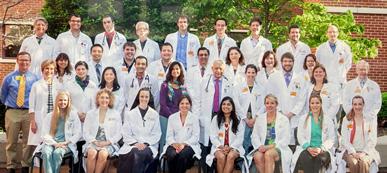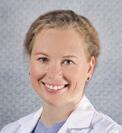Scholarly Activity
CARDIOVASCULAR DISEASE PUBLICATIONS:
Fogelson B, Livesay J, Rohrer M, Edwards M, Hirsh JB. Prevotella bivia cardiac implantable electronic device related endocarditis. IDCases. 2022;28:e01499.
Published 2022 Apr 9. doi:10.1016/j.idcr.2022.e01499. PMID: 35464738
Goodwin E, Fogelson B, Cox JW Jr, Mahlow WJ. An algorithm for pacing and cardioverting electronic devices undergoing magnetic resonance imaging: The PACEDMRI protocol. Magn Reson Imaging. 2023;96:44-49. doi:10.1016/j.mri.2022.10.012. PMID: 36441043
Stephens S, Fogelson B, Goodwin RP, Baljepally GK, Baljepally R. Takotsubo Cardiomyopathy secondary to cryptococcal meningoencephalitis in a patient With multiple sclerosis. J Med Cases. 2022;13(6):263-268. doi:10.14740/jmc3884. PMID: 35837075
Isang E, Stephens S, Coombes T, Abney L, Baljepally G. Left atrial thrombus after placement of watchman device. Clin Case Rep. 2022;10(10):e6410. Published 2022 Oct 22. doi:10.1002/ccr3.6410. PMID: 36285035
Almeida S, Shaikh K, Memon S, Singh V, Thomas D. Harnessing imaging biomarkers to refine individualized cardiovascular disease risk: a case-based discussion. Coron Artery Dis. 2022 Nov 1;33(7):574-579. doi: 10.1097/MCA.0000000000001173. Epub 2022 Aug 9. PMID: 35942620.
Lee J, Shaikh K, Nakanishi R, Gransar H,Achenbach S, Al-Mallah MH, Andreini D, Bax JJ, Berman DS, Cademartiri F, Callister TQ, Chang HJ, Chinnaiyan K, Chow BJW, Cury RC, DeLago A, Feuchtner G, Hadamitzky M, Hausleiter J, Kaufmann PA, Kim YJ, Leipsic JA, Maffei E, Marques H, de Araújo Gonçalves P, Pontone G, Rubinshtein R, Villines TC, Lu Y, Peña JM, Lin FY, Min JK, Shaw LJ, Budoff MJ. Prognostic significance of nonobstructive left main coronary artery disease in patients with and without diabetes: long-term tutcomes from the CONFIRM registry. Heart Lung Circ. 2022 Nov 3:S1443-9506(22)01126-X. doi: 10.1016/j. hlc.2022.09.014. Epub ahead of print. PMID: 36336615.
Shaikh K, Ahmed A, Gransar H, Lee J, Leipsic J, Nakanishi R, Alla V, Bax JJ, Chow BJW, Berman DS, Maffei E, Lin FY, Ahmad A, DeLago A, Pontone G, Feuchtner G, Marques H, Min JK, Hausleiter J, Hadamitzky M, Kaufmann PA, de Araújo Gonçalves P, Cury RC, Kim YJ, Chang HJ, Rubinshtein R, Villines TC, Lu Y, Shaw LJ, Acenbach S, Al Mallah MH, Andreini D, Cademartiri F, Callister TQ, Budoff MJ. Extent of subclinical atherosclerosis on coronary computed tomography and impact of statins in patients with diabetes without known coronary artery disease: Results from CONFIRM registry. J Diabetes Complications. 2022 Dec;36(12):108309. doi: 10.1016/j. jdiacomp.2022.108309. Epub 2022 Sep 15. PMID: 36444796
Goodwin E, Fogelson B, Cox JW Jr, Mahlow WJ. An algorithm for pacing and cardioverting electronic devices undergoing magnetic resonance imaging: The PACEDMRI protocol. Magn Reson Imaging. 2023 Feb;96:4449. doi: 10.1016/j.mri.2022.10.012. Epub 2022 Oct 27. PMID: 36441043
Taylor J, Assaf A, Assaf M, Assaf S, Shepple B, Kassira A. Pulmonary Fibroelastoma: A Rare Cardiac Mass Presenting With Dyspnea. CASE. 2022, ISSN 2468-6441, https://doi.org/10.1016/j.case.2022.10.003
Almeida S, Shaikh K, Memon S, Singh V, Thomas D. Harnessing imaging biomarkers to refine individualized cardiovascular disease risk: a case-based discussion. Coron Artery Dis. 2022 Nov 1;33(7):574-579. doi: 10.1097/MCA.0000000000001173. Epub 2022 Aug 9. PMID: 35942620.
Fogelson B, Black W, Goodwin RP, Dieter R 3rd, Baljepally R. Asymptomatic Aorto-Atrial Fistula Secondary to Surgical Repair of Ascending Aortic Dissection: When to Do Nothing. JACC Case Rep. 2022 Jul 20;4(14):868-870. doi: 10.1016/j. jaccas.2022.04.013. eCollection 2022 Jul 20
Livesay J, Fogelson B, Tahir H, Baljepally R. Comparison of Tricuspid Regurgitation Severity Between Cardiac Resynchronization Therapy Versus Right Ventricular Pacing in Patients With Chronic Obstructive Pulmonary Disease. Cardiol Res. 2022 Jun;13(3):128134. doi: 10.14740/cr1365. Epub 2022 Jun 16.
Baljepally R, Tahir H, Goodwin RP, Livesay J, Fogelson B, Patel C, Coombes T, Wadi G, Dieter R 3rd. Comparison of Transcatheter Aortic Valve Implantation Outcomes Between Normal-Flow, Low-Gradient Severe
Aortic Stenosis and Normal-Flow, High-Gradient Severe Aortic Stenosis. Cardiovasc Revasc Med. 2022 Jun;39:12-17.doi: 10.1016/j.carrev.2021.10.020. Epub 2021 Nov 2
Fogelson B, Goodwin RP, Tahir H, Baljepally R. Rural Versus Urban Outcomes Following Transcatheter Aortic Valve Implantation. JSCAI. 2022 May 01. p. 100183
Tahir H, Livesay J, Fogelson B, Coombes T, Patel C, Baljepally R. Use of the CHA2DS2-VASc Score in Assessing Transradial Approach Failure. Cardiovasc Revasc Med. 2022 Mar;36:107-112. doi: 10.1016/j. carrev.2021.05.023. Epub 2021 May 28. PMID: 34140231.
Livesay J, Baljepally R, Fogelson B, et al. Short-Term Outcomes after Transcatheter Aortic Valve Implantation in Low Flow Low Gradient Versus Normal Flow Low Gradient Aortic Stenosis. J Am Coll Cardiol. 2022 Mar, 79 (9_Supplement) 679.
Tahir H, Livesay J, Baljepally R, et al. Improving Impella Hemodynamics Using Temporary Atrioventricular (AV) Sequential Pacing in a Patient with Cardiogenic Shock and Complete Heart Block. J Am Coll Cardiol. 2022 Mar, 79 (9_Supplement) 3430
Goodwin E, Goodwin RP, Abney L, et al. Bevacizumab-Associated Left Anterior Descending Artery Occlusion in a Young Woman with Neurofibromatosis type 2. J Am Coll Cardiol, 2022 Mar, 79 (9_Supplement) 2210. Doi: 10.1016/S0735-1097(22)03201-6
Fogelson B, Tahir H, Livesay J, Baljepally R. Pathophysiological factors contributing to fractional flow reserve and instantaneous wave-free ratio discordance. Rev Cardiovasc Med. 2022 Feb 18;23(2):70. doi: 10.31083/j.rcm2302070
Fogelson B, Livesay J, Johnson JH. Inferior Myocardial Infarction Secondary to Coronary Artery Vasospasm Following Regadenoson Stress Imaging. J Med Cases. 2022 Jan;13(1):11-14. doi: 10.14740/ jmc3850. Epub 2022 Jan 17. PMID: 35211229; PMCID: PMC8827252
PULMONARY CRITICAL CARE PUBLICATIONS
Bhagat M, Singh A, Bazzi T, Green J. Bronchorrhea: a rare and debilitating symptom of lung cancer: case report and review of the treatment. JTO Clinical and Research Reports. 2022 Oct;3(10) https://doi.org/10.1016/j. jtocrr.2022.100398. PMID: 36164316
Vijayan K, Karakattu SM, Bansal A, Thomas A, Alazzeh A, El Minaoui W, Maisonet M. Immediate complications and flow volume changes during treatment phases of bronchial thermoplasty: a single-center descriptive study. J Asthma. 2022 Jul;59(7):1433-1437. doi: 10.1080/02770903.2021.1924775. Epub 2021 May 18. PMID: 33947298.
Zhou CY, Sahay S, Shlobin O, Soto FJ, Mathai SC, Melendres-Groves L, Mullin CJ, Levine DJ, Kay D, Highland K, Bossone E, Poms A, Memon H, Balasubramanian V, Farmer MJS, Rahaghi F, Elwing JM. Effects of COVID-19 pandemic on the management of pulmonary hypertension. Respir Med. 2023 Jan;206:107061. doi: 10.1016/j.rmed.2022.107061. Epub 2022 Nov 26. PMID: 36493604; PMCID: PMC9699715 Wong F, Doyle-McClam M, Pugh S, Dudney T, McCormack M, Kravitz J. Diagnostic and treatment dilemma during the coronavirus disease 2019 pandemic: a primary pulmonary lymphoma presenting as a cavitary mass in a patient with coronavirus disease 2019: a case report. J Med Case Rep. 2023 Jan 13;17(1):12. doi: 10.1186/s13256-022-03745-5. PMID: 36635758; PMCID: PMC9836925
Fogelson B, Qu D, Bhagat M, Branca PR. Multiorgan system failure secondary to difluoroethane toxicity in a patient “huffing” air duster: a case report. J Addict Dis. 2022 Oct-Dec;40(4):577-582. doi: 10.1080/10550887.2022.2027207. Epub 2022 Jan 19. PMID:35044291.
Olanipekun T, Abe T, Effoe V, Chris-Olaiya A, Biney I, Guru P, Ritchie C, Sanghavi D. Utilization trends and outcomes of catheter-directed thrombolysis for pulmonary embolism in the US by race/ethnicity. J Thromb Thrombolysis. 2022 Nov;54(4):675-685. doi: 10.1007/ s11239-022-02710-9. Epub 2022 Oct 11. PMID:36219337.1
Zhou CY, Sahay S, Shlobin O, Soto F, Mathai S, Melendres-Groves L, Mullin CJ, Levine DJ, Kay D, Highland K, Bossone E, Poms A, Memon H, Balasubramanian V, Farmer MJS, Rahaghi F, Elwing JM. Effects of COVID-19 pandemic on the management
of pulmonary hypertension. Respir Med. 2023 Jan;206:107061. doi: 10.1016/j.rmed.2022.107061. Epub 2022 Nov 26. PMID: 36493604.
Soto FJ, Biney IN, Akhtar Y, McKeown PP, Turner JF. Abnormal Cardiac Ultrasound Imaging in a Patient With Sudden Neurologic Deficit. Chest. 2022 Sep;162(3):e145-e148. doi: 10.1016/j. chest.2021.09.043
Li J, Alolaiwat A, Fink JB, Dhand R. AerosolGenerating Procedures and Virus Transmission. Respir Care. 2022 Aug;67(8):1022-1042. doi: 10.4187/ respcare.10160. Epub 2022 Apr 6
Harnois LJ, Alolaiwat AA, Jing G, Fink JB, Dhand R, Li J. Efficacy of Various Mitigation Devices in Reducing Fugitive Emissions from Nebulizers. Respir Care. 2022 Apr;67(4):394-403. doi: 10.4187/respcare.09546. Epub 2021 Nov 9
Li J, A Alolaiwat A, J Harnois L, Fink JB, Dhand R. Mitigating Fugitive Aerosols During Aerosol Delivery via High-Flow Nasal Cannula Devices. Respir Care. 2022 Apr;67(4):404-414. doi: 10.4187/respcare.09589. Epub 2021 Nov 17. PMID: 34789564
Sahay S, Balasubramanian V, Memon H, Poms A, Bossone E, Highland K, Kay D, Levine DJ, Mullin CJ, Melendres-Groves L, Mathai SC, Soto FJ, Shlobin O, Elwing JM. Utilization of risk assessment tools in management of PAH: A PAH provider survey. Pulm Circ. 2022 Apr 8;12(2):e12057. doi: 10.1002/pul2.12057. eCollection 2022 Apr
Swanson CS, Dhand R, Cao L, Ferris J, Elder CS, He Q. Microbiome-based source identification of microbial contamination in nebulizers used by inpatients. J Hosp Infect. 2022 Apr;122:157-161. doi: 10.1016/j. jhin.2022.01.008. Epub 2022 Jan 23
Zarogoulidis P, Kosmidis CS, Hohenforst-Schmidt W, Matthaios D, Sapalidis K, Petridis D, Perdikouri EI, Courcoutsakis N, Hatzibougias D, Arnaoutoglou C, Freitag L, Ioannidis A, Huang H, Tolis C, Bai C, Turner JF. Radial-EBUS: CryoBiopsy Versus Conventional Biopsy: Time-Sample and C-Arm. Int J Environ Res Public Health. 2022 Mar 17;19(6):3569. doi: 10.3390/ ijerph19063569
Ohar JA, Ferguson GT, Mahler DA, Drummond MB, Dhand R, Pleasants RA, Anzueto A, Halpin DMG, Price DB, Drescher GS, Hoy HM, Haughney J, Hess MW, Usmani OS. Measuring Peak Inspiratory Flow in Patients with Chronic Obstructive Pulmonary Disease. Int J Chron Obstruct Pulmon Dis. 2022 Jan 6;17:79-92. doi: 10.2147/COPD.S319511. PMID: 35023914; PMCID: PMC8747625
Dhand R. Inhaled Tobramycin for Treatment of Ventilator-Associated Pneumonia: The Interplay of Patient, Drug, and Device. Respiratory Care January 2022, 67 (1) 151-153; https://doi.org/10.4187/ respcare.09852
Gutierrez A, Gerbo M, Treat S, Sharma N, Jordan S, Dudney T. A New Meaning to Chest Tightness: Tension Pneumomediastinum and Bedside Mediastinotomy In SARS- CoV-2. Critical Care Medicine: January 2022 – Volume 50 - Issue 1 - p 131. doi: 10.1097/01. ccm.0000807484.94614.ad
OTHER PUBLICATIONS:
Svynarenko R, Lindley LC, Mooney-Doyle K, Mendola A, Naumann WC, Mack JW. Patterns of healthcare services among children with advanced cancer in concurrent hospice care. Cancer Nurs. 2022 Nov-Dec 01;45(6):E843-E848. doi: 10.1097/ NCC.0000000000001067. Epub 2022 Feb 16. PMID:35175949.
Schildkraut JM, Johnson C, Dempsey LF, Qin B, Terry P, Akonde M, Peters ES, Mandle H, Cote ML, Peres L, Moorman P, Schwartz AG, Epstein M, Marks J, Bondy M, Lawson AB, Alberg AJ, Bandera EV. Survival of epithelial ovarian cancer in Black women: a society to cell approach in the African American cancer epidemiology study (AACES). Cancer Causes Control. 2022 Dec 15:1-15. doi: 10.1007/s10552-022-01660-0. Online ahead of print. PMID:36520244.
Zayas LE, Walker RH. Amantadine treatment for hyperkinetic movements in chorea-acanthocytosis. Mov Disord Clin Pract. 2022 Dec 20;10(2):346-347. doi: 10.1002/mdc3.13623. eCollection 2023 Feb. PMID: 36825061.
5
Ethics Case Rounds
Ethics Case Rounds are monthly, hospital-wide discussions of morally distressing cases. Cases are deidentified to protect patient confidentiality.
“Roberta” is a 40-year-old lady, 18 weeks pregnant, who was admitted for increased dyspnea due to COVID-19. She reported good fetal movement and denied vaginal bleeding, loss of fluid, and contractions. She lived with her husband and their five children about 90 minutes away. They have supportive family nearby. She and her family tend to avoid conventional medicine and prefer to maintain health with diet, exercise, meditation, and herbal remedies. She delivered her children at home and plans to do the same for this baby. She declined Remdesivir and only reluctantly agreed to supplemental oxygen by nasal cannula.
Unfortunately, Roberta’s condition worsened. Her physician strongly encouraged her to reconsider Remdesivir. She declined, saying she prefers to avoid medications, especially since she is pregnant. She was also worried that use of oxygen by nasal cannula would create a dependence on oxygen therapy. Her physician explained the effects of the medications and oxygen therapy, their risks and benefits, and expected sequelae with/without them. Roberta continued to decline Remdesivir but agreed to reconsider if she continued to worsen.
Roberta’s oxygen needs continued to increase. By day 5, she had accepted Remdesivir and high-flow nasal cannula at 10L/min but was very frustrated with the hospital milieu and wanted to leave against medical advice (AMA). She felt she would do better at home, where she has access to healthy food, her own bed, sunshine and fresh air, and freedom to move around. “I don’t care about numbers -- I know my body and my baby.” Her physicians believed her oxygen needs were too great for her to be at home safely. Moreover, if she suffered a rapid deterioration, it could have catastrophic consequences for her and her baby. An ethics consult was requested.
Informed Choice and Pregnancy
It is very common for pregnant patients to decline an intervention(s) at some point during pregnancy, birth, or postpartum. Most providers accept when informed, capacitated patients refuse an intervention. Unfortunately, a significant minority of providers respond with disrespect, attempts to coerce, and even to proceed over the patient’s objections. Patients whose providers responded with disrespect, coercion, or force reported responses ranging from disappointment to trauma. They were also more likely to avoid medical care in future. In contrast, patients who trust their health care providers are more likely to accept recommendations and are more willing to collaborate when they do decline an intervention.
The ethical principle of patient autonomy and the goal of informed choice is not diminished by pregnancy. Health care providers have the responsibilities to ensure that patients, including pregnant patients are informed of risks, benefits, and alternatives, have decision making capacity for the decisions at hand, and are not making decisions under duress.
Roberta’s care team met with her and her family to discuss how to maximize the well-being of Roberta and her fetus. All agreed with a plan to maintain as homelike an atmosphere as possible (e.g., no routine vitals from 8pm6am, family would bring food from home) and try to wean her oxygen needs to a level that could be provided at home. If she could maintain adequate oxygen saturation, then her recovery could be managed at home. If not, the plan was to continue the hospitalization.
The day she completed her course of Remdesivir, she was maintaining oxygen saturations in the mid-90s on <6L of oxygen per minute and again asked to leave AMA. Her providers felt she should stay but worked with her to develop a plan for her to continue with her medications and oxygen at home, to monitor her oxygen needs, and to return to the hospital if needed.
Comments on this case may be sent to amendola@utmck.edu
References
• Informed Consent and Shared Decision Making in Obstetrics and Gynecology: ACOG Committee Opinion Summary, Number 819. Obstet Gynecol. 2021;137(2):392-393. doi:10.1097/AOG.0000000000004248
• Kotaska A. Informed consent and refusal in obstetrics: A practical ethical guide. Birth. 2017;44(3):195-199. doi:10.1111/birt.12281
Presentations, Publications, Awards
Department of Medicine faculty, residents, and fellows share their knowledge and experience by publishing and presenting across the world. For a list of our most recent accomplishments, visit http://gsm.utmck.edu/internalmed/scholars.cfm.
Thank You For Your Support
For information about philanthropic giving to the UT Graduate School of Medicine, Department of Medicine, please contact the Development Office at 865-305-6611 or development@utmck.edu.
If you would like more information about any of the topics in this issue of In Touch, please contact the Department of Medicine at 865-305-9340 or visit http://gsm.utmck.edu/internalmed/main.cfm.
We look forward to your input. Thank you.
Stay In Touch!
Alumni, please update your contact information by completing the simple form at http://gsm.utmck.edu/internalmed/alumni.cfm or by calling the Department of Medicine at 865-305-9340. Thank you!
In Touch
Vol. 121 Issue 5:
January 2023
Publisher
Rajiv Dhand, MD, Chair, Department of Medicine and Associate Dean of Clinical Affairs
Editor
Annette Mendola, PhD
Administrative Director
Jenny Roark
Contributors
Jenny Roark
Robin Underwood
Rajiv Dhand, MD
Annette Mendola, PhD
Cassandra Mosley
James Drew, MD
Marc Oropilla, DO
Shawna Stephens, DO
Ashley Gutierrez-Santana, MD Add Erin Hamric, DO Logan Shaver, DO
Design
J Squared Graphics
In Touch is produced by the University of Tennessee Graduate School of Medicine, Department of Medicine. The mission of the newsletter is to build pride in the Department of Medicine by communicating the accessible, collaborative and human aspects of the department while highlighting pertinent achievements and activities.
Contact Us
In Touch
University of Tennessee
Graduate School of Medicine
Department of Medicine
1924 Alcoa Highway, U-114 Knoxville, TN 37920
Telephone: 865-305-9340
E-mail:
InTouchNewsletter@utmck.edu
Web: http://gsm.utmck.edu/ internalmed/main.cfm
The University of Tennessee is an EEO/AA/Title VI/ Title IX/Section 504/ADA/ ADEA institution in the provision of its education and employment programs and services.
Disclaimer: quotes/ interviews are edited for length and clarity
6




















